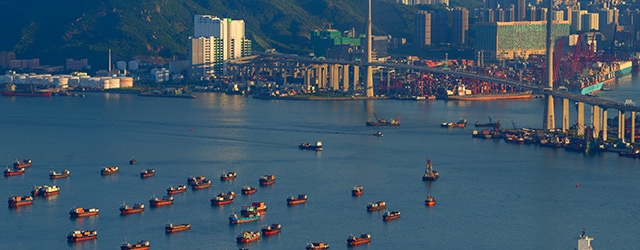New patterns are disrupting global trade, altering relationships and reshaping international business practices.

Good news: International trade is finally picking up. The World Bank’s latest Global Economic Prospect points to a recovery in trade growth to 4% this year after a long period of stagnation. Trade grew at just 2.5% in 2016, the slowest rate since the financial crisis of nearly a decade ago.
“Among the positive signs are improved growth in many economies, with export orders up, higher volumes of container traffic and more-stable commodity prices,” says Arancha González, executive director of the International Trade Centre (ITC), the joint agency of the UN Conference on Trade and Development (Unctad) and the World Trade Organization (WTO). However, at this stage she still sees “a fragile recovery.”

Dr. Frank van Tongeren, who heads the Policies in Trade and Agriculture division of the Organization for Economic Cooperation and Development (OECD), points to the upturn in economic activity in the US, the EU and Japan as helping the revival. As if to illustrate his point, on July 5, EU trade commissioner Cecilia Malmström and Japanese foreign minister Fumio Kishida announced they had achieved consensus on a Japan-EU Economic Partnership Agreement. Still, van Tongeren cautions that “trade growth remains slow and we can’t say whether it’s sustainable in the long term.”
The World Bank sees this economic recovery as broad based, with GDP growth in advanced economies expected to accelerate to 1.9% this year, and emerging market and developing economies as a whole growing by 4.1% compared with 3.5% last year. But how much of this can be attributed to cyclical factors?
John Lorié, global chief economist at Atradius, the trade credit insurance arm of Spanish insurer Grupo Catalana Occidente, sees the “significantly higher growth in trade this year as part of a broader cyclical upturn, with GDP growth picking up across most regions and particularly in Asia and Latin America, where Argentina and, to a lesser extent, Brazil, are coming out of recession.”
Lorié adds that “China putting some stimulus into the economy has helped the pickup in commodity prices, and this will support previously lackluster levels of investment in sectors like oil and mining.” That in turn should boost global trade because, as he notes, “investment helps trade more than growth in consumption.” China’s recently inaugurated One Belt, One Road initiative, “will not only lead eventually to greater economic integration,” according to van Tongeren, but also have more immediate impacts on world trade. “As a massive infrastructure project,” he says, “it will help sustain demand for raw materials like steel needed for building it.”
A pickup in global trade growth this year to 4% would assuredly be welcome, even though it pales in comparison to the average growth of 7.6% per year leading up to the financial crisis, when global trade consistently outpaced overall expansion in global GDP. Many factors could explain what appears to be a secular decline in global trade: lower levels of business confidence and investment; demand cycles and their impact on commodity prices; the maturing of global value chains, which have in turn triggered structural changes in the composition of cross-border trade; and deficiencies in how global trade data is captured and measured.

For some observers, the slowdown in world trade can be explained in one word: China. As the world’s largest exporter, China has long been the engine of growth in global trade, but that is beginning to change. “Slower growth in China last year, and the economy’s pivot away from capital investment and more toward consumerism, triggered a slowdown in much of the rest of Asia,” observes Munir Nanji, head of Citi’s Global Subsidiaries Group for Asia-Pacific, which supports the subsidiaries of multinational clients across the region. “There has also been a slowdown of net exports out of Asia to the West,” he adds.
Continuing political uncertainties have acted as a brake on investment, and this may still be dampening growth in trade. Nanji notes that “political uncertainty, with key elections being held this year not only in Europe but in India, Singapore and Thailand, has had a domino effect on trade.”
“Downside threats include the emergence of geopolitical risks, especially in Asia, and antiglobalization rhetoric in some parts of the world, which could lead to protectionist policies,” says González. She also points to the possibility of further monetary tightening, and continuing uncertainty about Brexit and the direction of US policy, as holding back investment decisions and therefore trade.
At the same time, structural changes in the makeup of global trade could hold back any return to pre–financial crisis levels of growth. Crucially, the extension of global value chains may have peaked. “The integration of value chains has reached a limit,” says Lorié.
Professor Thomas W. Hertel, executive director of the Center for Global Trade Analysis at Purdue University and founder of the Global Trade Analysis Project, points out: “Most cross-border trade is in intermediate goods. As the global supply chain has spread, such goods cross international borders many times, accumulating value-added along the way. But that process can be reversed.” González says that these extended value chains, especially those in Asia that are mostly built around China, are changing. Some reshoring has started, as China moves toward more value-added activities and the economy tilts toward domestic consumption.
“China has already built its supply chains,” says Nanji, so the boost to trade from setting up such facilities is largely over. And, as Lorié observes, “China is moving up the value chain and producing more locally, which implies less trade with neighboring Asian countries.”

But it isn’t just in China that Hertel sees signs of the supply chains being reeled in. “There has been some reshoring or migration toward clusters where the final good is produced, possibly to facilitate ‘just-in-time’ systems and processes.” This can appear to observers as “an apparent bias toward consuming your own goods rather than those from abroad,” Hertel says. The geographical balance of international trade has already changed dramatically. Asia recorded the largest regional year-on-year increase in services in 2016 on both the export and import sides (0.9% and 2.6%, respectively), according to the WTO. “There has been a shift in the overall composition of global trade,” says Hertel, “toward that between developing countries, and this is dominated by Asia.”
While President Trump may wish to reverse that process, and has pulled the US out of the Trans-Pacific Partnership, the momentum toward more south-south trade—between Southern Hemisphere countries—is unstoppable. “Even after US disengagement with the TPP, other countries including Australia are signaling they are willing to continue with closer trade integration,” observes van Tongeren.
In the absence of a broader trade agreement, Nanji expects to see more intraregional trade deals come out of Asia, mostly in the form of bilateral agreements. Others remain skeptical. The OECD’s van Tongeren says that while “there is a lot of dialogue about closer market integration in Africa and in Asia, particularly among the ASEAN-15, the results of this remain to be seen.”
Another structural shift, van Tongeren says, is that “trade in services—especially business services—is growing much faster than that in goods.” This was reflected in the priorities of the 225 leading economists and policymakers who assembled last month for the 20th Annual Conference on Global Economic Analysis, held at Purdue University. Purdue is home to the Global Trade Analysis Project and its open-source database, allowing shared access to information and analytical tools, which Hertel says “have helped level the playing field, especially for developing countries.”
At this year’s conference, Hertel says, the focus shifted from analyzing and shaping trade policy toward analysis of supply chains and the broader effects of trade activity, such as environmental impacts and climate change. And here the role of multinationals and their affiliates is crucial.

According to research by Unctad, intrafirm transactions accounted for nearly a third of all global exports in 2015, with vertically integrated multinationals like Intel, Nokia and Samsung Electronics leading the way with intrafirm trading, while companies like Apple and Nike rely mainly on outsourcing and arm’s-length trade with nonaffiliated suppliers. What’s more, the World Bank has found that intrafirm transactions have been much more resilient since the financial crisis than arm’s-length trade.
Intrafirm transactions along extended value chains—with the same goods crossing and recrossing borders—may well have skewed statistics. “We are not looking at trade figures in the right way,” says González. “We measure trade in gross flows, not value added, so the figures give a less accurate picture of what’s happening on the ground. We need to crunch trade figures as value added.”
Van Tongeren believes the higher growth rates in trade before 2008 were partly a result of this period that saw “the restructuring of global manufacturing,” though he adds that the focus on gross trade flows could have resulted in some double counting. “If you look at it in value-added terms,” he says, “you have much more harmonious growth patterns. And that’s what counts, because it’s value added that feeds into GDP and income growth.”
González highlights the “need to capture data better, especially on services to trade and digital commerce, which are growing faster than trade in goods.” And while digital-commerce growth has long been providing a boost to advanced economies, Nanji sees the growing importance of ecommerce in Asia, with a younger generation of Asians used to technology and increasingly buying online, as delivering a similar stimulus to regional trade.
But this poses yet further difficulties in measuring trade flows. As Hertel observes, “With digital commerce, where the money’s flowing is not always an indicator of where the service was provided or where it is consumed.”
Looking ahead, González sees greater potential for expansion in the more fragmented markets of Latin America and Africa, where value chains are less developed. And while protectionist rhetoric is on the rise, some things are improving. Lorié says that agreement on WTO rules to improve customs practices (the Trade Facilitation Agreement) will reduce costs at borders and should provide a significant boost to global trade over time, especially in the emerging economies.
But there are also drags on future growth, such as trade finance gaps. “Globally, there is a $1.6 trillion shortfall,” says Lorié. “The amount for Asia stands at $700 billion.” He also notes that some 1,681 restrictive practices have been introduced by G20 countries since 2008, of which only 408 have been removed. “And this,” he adds, “is before the US took a more protectionist stance.”
The spectre of future trade wars is probably the biggest brake on global trade and investment. González points out that while some societies are looking back to the 20th century, “their political systems are run on 19th century lines, and their economies are going through a technology-driven transformation.”
“The reaction of ‘let’s close our doors’ is an illusion,” she says, “given the way that technology works.” In future, trade policies need to be more integrated with social policies, education and safety nets, to avoid such a backlash. Hertel, for one, argues that not enough has been done on some of the consequences of globalization, especially for those who have ‘lost out.’ “People aren’t as mobile across sectors and communities as economists might think,” he says.



